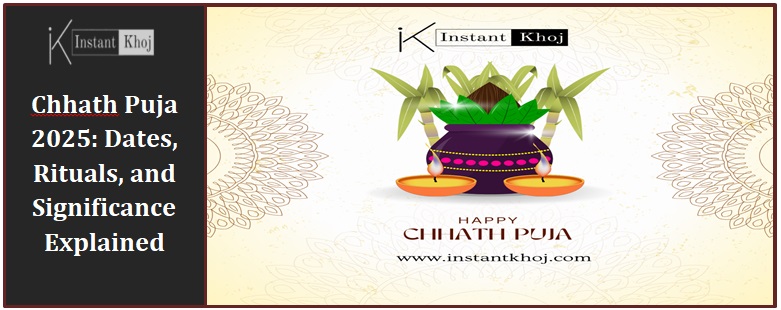Table of Content
- Introduction
- Key Dates and Rituals of Chhath Puja 2025
- Day 1 – Nahay Khay (Saturday, October 25, 2025)
- Day 2 – Kharna (Sunday, October 26, 2025)
- Day 3 – Sandhya Arghya (Monday, October 27, 2025)
- Day 4 – Usha Arghya (Tuesday, October 28, 2025)
- Significance of Chhath Puja
- Preparation and Offerings
- Frequently Asked Questions (FAQs)
- Conclusion
Introduction
Chhath Puja, one of the most spiritually rich and ecologically significant festivals of India, is dedicated to the worship of Lord Surya (the Sun God) and his divine consort Chhathi Maiya. The festival is especially celebrated in the Indian states of Bihar, Jharkhand, Uttar Pradesh, and some regions of Nepal, but its devotion and grandeur have now spread to many parts of India and even abroad, wherever the Indian diaspora resides.
Chhath Puja is unique because it does not involve any idol worship. Instead, it focuses on worshipping the natural elements — primarily the Sun, water, and earth — which sustain life on our planet. The festival also stands as a symbol of purity, faith, and discipline.
In 2025, Chhath Puja will be observed from October 25 (Saturday) to October 28 (Tuesday). Over these four days, devotees perform various rituals with immense devotion and sincerity, thanking the Sun God for sustaining life and seeking blessings for health, prosperity, and happiness.
Key Dates and Rituals of Chhath Puja 2025
Day 1 – Nahay Khay (Saturday, October 25, 2025)
Meaning: The term “Nahay Khay” literally translates to “bathe and eat.” It marks the beginning of the four-day festival and focuses on purification — both of the body and the soul.
Rituals:
- Devotees begin their day by taking a holy dip in rivers, ponds, or other natural water bodies, symbolizing physical and spiritual cleansing.
- Homes are thoroughly cleaned to create a pure environment.
- The first meal after the ritual bath is satvik (pure vegetarian) and is prepared without onion, garlic, or even salt. Common dishes include rice, pumpkin curry, lentils, and ghee.
- This day signifies starting the festival with purity, discipline, and a clean heart.
Nahay Khay sets the tone for the following days — it’s about simplicity, humility, and beginning a sacred journey toward spiritual cleansing.
Day 2 – Kharna (Sunday, October 26, 2025)
Meaning: “Kharna” represents the offering and consumption of prasad (sacred food) prepared after a full day of fasting.
Rituals:
- On this day, devotees observe a nirjala vrat (fast without food and water) from sunrise to sunset.
- As evening arrives, devotees prepare jaggery kheer (sweet rice pudding made with jaggery and milk), along with roti and fruits.
- The prasad is offered to Chhathi Maiya and then consumed by the devotees to break the fast.
- After this, devotees again begin a 36-hour long fast without water, which continues until the completion of Usha Arghya on the fourth day.
Kharna reflects devotion, endurance, and inner strength. It also brings families and communities together, as the sweet aroma of jaggery kheer fills homes, symbolizing unity and gratitude.
Day 3 – Sandhya Arghya (Monday, October 27, 2025)
Meaning: “Sandhya” means evening and “Arghya” means offering. This day is the most visually spectacular part of Chhath Puja, where devotees worship the setting Sun.
Rituals:
- As the Sun prepares to set, devotees gather along riverbanks or ponds, dressed in traditional attire. Women often wear bright sarees, and men wear dhoti-kurta.
- Devotees stand waist-deep in water, holding bamboo trays (soop) filled with offerings such as thekua (a traditional sweet made of wheat, jaggery, and ghee), fruits, sugarcane, coconuts, and diyas (earthen lamps).
- With folded hands, they offer Arghya to the setting Sun, expressing gratitude for the life-giving energy and seeking blessings for prosperity and well-being.
- Traditional Chhath songs and folk music fill the air, creating a serene and devotional atmosphere.
This ritual is deeply symbolic. Offering prayers to the setting Sun represents humility and thankfulness — acknowledging that every ending carries the seed of a new beginning.
Day 4 – Usha Arghya (Tuesday, October 28, 2025)
Meaning: “Usha” refers to dawn, and “Arghya” means offering. The final day of Chhath Puja is dedicated to the rising Sun, symbolizing hope, renewal, and new life.
Rituals:
- Devotees gather again at the riverbanks before sunrise, often before dawn.
- With the first rays of sunlight, they offer Arghya to the rising Sun, thanking him for the light, warmth, and vitality that sustains life on Earth.
- After completing the prayers, devotees break their fast by consuming prasad and sharing it with family and neighbors.
This final ritual marks the end of Chhath Puja, filling hearts with peace, gratitude, and spiritual fulfillment. It’s believed that observing Chhath with true devotion can bring blessings equivalent to divine grace.
Significance of Chhath Puja
Chhath Puja carries profound spiritual, ecological, and social meaning. Its importance goes beyond religion — it’s a festival that connects humans with nature.
- Worship of the Sun God: The Sun is considered the eternal source of energy and life. Worshipping the Sun God and his consort, Chhathi Maiya, symbolizes gratitude for sustaining life and ensuring balance in nature. Devotees pray for good health, longevity, and prosperity.
- Symbol of Environmental Awareness: Chhath Puja promotes environmental consciousness. Devotees clean rivers, ponds, and surrounding areas before performing rituals. This reflects an ancient yet relevant understanding of ecological balance and the interdependence between humans and nature.
- Strengthening Community Bonds: Chhath is a community festival. Families, friends, and neighbors come together to prepare offerings, decorate ghats, and help each other during the rituals. It’s a time of unity, cooperation, and shared faith.
- Spiritual Discipline and Purity: The fasting and rituals of Chhath Puja demand immense discipline, mental strength, and devotion. Through self-control and dedication, devotees purify their minds and bodies, aligning themselves with the spiritual energy of the Sun.
Preparation and Offerings
Chhath Puja preparations begin several days in advance. Every item used has symbolic and spiritual value.
Essential Offerings Include:
- Thekua: A signature sweet dish made from wheat flour, jaggery, and ghee — symbolizing simplicity and devotion.
- Fruits: Especially bananas, apples, and pomegranates — representing fertility and abundance.
- Sugarcane: A symbol of prosperity and sweetness in life.
- Coconut: Represents purity and completeness.
- Earthen Pots (Soop or Daura): Used to carry offerings during rituals.
- Clay Diyas (Oil Lamps): Lit to symbolize light overcoming darkness.
- Ganga Jal (Holy Water): Used for purification during the rituals.
- Flowers: Especially marigolds, used for decoration and worship.
All offerings are arranged beautifully and presented to the Sun God during the Arghya rituals. Devotees ensure everything used is natural, fresh, and unprocessed — reflecting respect for purity and nature.
Frequently Asked Questions (FAQs)
Q1: Why is Chhath Puja celebrated?
A1: Chhath Puja is celebrated to worship the Sun God and express gratitude for sustaining life on Earth. It is believed that worshipping Surya and Chhathi Maiya grants good health, happiness, and prosperity.
Q2: Can anyone observe Chhath Puja?
A2: Yes. Traditionally, women lead the rituals, but men and children also participate with devotion. In many families, both husband and wife observe the fast together.
Q3: What does fasting signify during Chhath Puja?
A3: Fasting represents purity, discipline, and devotion. It helps devotees cleanse their body and mind, fostering spiritual growth.
Q4: Are there any special rituals for children?
A4: Children are not required to fast but can participate by offering flowers, lighting diyas, and helping elders in preparation.
Q5: How should one prepare for Chhath Puja?
A5: Preparation includes cleaning the house, collecting all necessary offerings, and setting up a clean and sacred space near a water body for the rituals.
Conclusion
Chhath Puja is not merely a religious festival — it is a celebration of nature, purity, and community spirit. Over four days, devotees demonstrate immense faith, endurance, and gratitude through disciplined rituals and heartfelt prayers. The beauty of Chhath lies in its simplicity — no grand idols, no lavish decorations — just pure devotion and a deep connection to nature.
As Chhath Puja 2025 (October 25–28) approaches, millions of devotees will gather along riverbanks, singing traditional songs, lighting diyas, and offering their prayers to the Sun. Beyond rituals, the festival reminds us of timeless values — respect for nature, discipline in life, and gratitude for the divine energy that sustains us all.
Also Read:
RBI Keeps Repo Rate Unchanged at 5.5%: What It Means for You
YouTube Premium Lite India Launch — Affordable Ad-Free Plan
Follow Blog’son Instantkhoj for more latest stories and trending topics.




